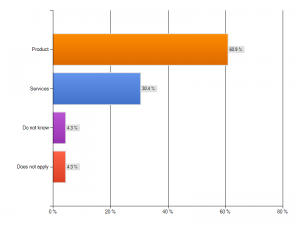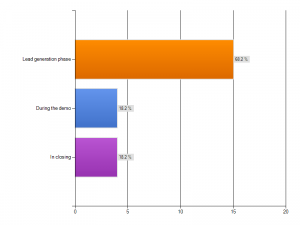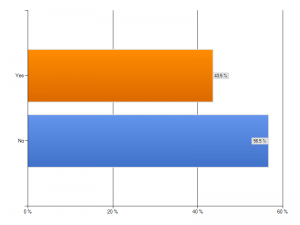Next Chef’s dinner menus posted, tickets available
Here you go all those who missed the first two chefs dinners, only 24 tickets for sale for each event. They go fast.
http://www.eventbee.com/event?eid=750077225
To purchase Tickets – Week 4:
Category: Technology Industry
Amazing chefs dinner!!!!

Amazing seafood dinner last night with Catering Company – Savoury Chef, Liberty Wines and supplier Organic Ocean. You had to be there. The flavors and pairings were amazing. Next week pork and the following week, venison and more!

- Image via Wikipedia
Category: Technology Industry
Why Buffett and Gates will not get that much charity donating in Asia.
Why Buffett and Bill Gates will not get that much charity donating in Asia. This is simple. (Lessons learned from working with Vancouver’s Asian run companies ) The Asian mindset is focused on the family. There is such an age long bond to family that to think about “giving” funds outside that is not part of the culture. If you want to approach charity fundraising in this market consider two must-have answers to business questions. (If you do not do this, there is no way to start to meet the givers needs.)
- Is this charity a good thing? Is it a good thing that they do? How does it help? Who does it help? What is the societal benefit of this? Why is that a good thing? Do not assume the audience shares your belief in the intrinsic good of giving or that saving lives in some far off country is important.
- What will the individual get out of the gift? What type of recognition is planned? Photo op? Celebratory dinner? Plaque for his office wall? Laudatory newspaper article? Do not make the mistake of the photo of Gates shaking the donor’s hand happening before the cheque clears the bank.
Also remember the preservation of face. By attending a fund-raising event will the potential donor be pressured socially to give? The fear of that is likely to prevent many from attending.

- Cover of Bill Gates

- Image via Wikipedia
Related articles
- Gates, Buffett Talk To China Wealthy About Charity (huffingtonpost.com)
- Gates and Buffett Say Charity Meeting a Success (dealbook.blogs.nytimes.com)
- Chinese billionaires accused of stinginess after charity banquet snub (guardian.co.uk)
- US billionaires Gates, Buffett impressed by passion among China’s wealthy for charity (taragana.com)
Category: Communication, Finance, Marketing
What generates the highest profit margin, product or service? Pricing part 3
What generates the highest profit margin, product or service? Pricing part 3.
This was a surprising data point from our Oct 2010 survey on pricing. I was expecting that the impact of product commoditization, SaaS, web apps, tied freemium offers and the ample opportunity to up sell present clients would have made an impact on the survey from other times. Most analysts say that products are being commoditized and true value is coming from services. But it seems not.
Mature companies like SAP and Oracle are able to create huge profits from their services group. IBM has swung the majority of its revenue with huge profits from services. Best Buys Geek Squad has bigger profits than the stores (its a growth department and they generate 60 % of income on products that come from competitors) .
At Rocket Builders we see in this data a reflection of a less mature approach to the market and ultimately pricing errors due to poor value communication in the surveyed companies. Yes, the technology community is a youthful one , but the companies have been around for a good length of time through many cycles, with ample opportunities to build more mature business models.
A company might have very valid reasons for not getting more margin from a services group. Perhaps:
- The customers say they will not pay for services
- The competition does not charge for service
- Its part of a short term penetration strategy
- The services may not be valuable
- There are no salable services
Perhaps you have lower services margin for preventable reasons such as:
- You do not up sell services
- You do not track margin erosion through the services group
- You “toss” services in with the product sale
- You never thought about it
- You do not know how to do that
- Its part of your history and culture
- You do not grow your services departments soft skills and technical expertise
- Your customer experience is just not that great
- Field services does not sell
Service revenue should be a large and growing profit center for a well run company. It requires current customer knowledge and the extraction of the value you help a customer get out of your solution. But these are areas where knowledgeable and experienced marketing and sales departments can really bring the value stories back to the services department. Customer testimonials are the gold that will fill your mint.
Not getting the profits you deserve is preventable. If you want to know more about how to get more value for your services, give Rocket Builders a ring. Bringing out customer value is what we do every day.
Related articles
- 6 characteristics of successful Freemiums (techvibes.com)
- The Competitive Edge: Differentiating Your Product or Service (pamil-visions.net)
- What IS Your Position On Customer Service? (customerthink.com)
- 3 Tips for Cross-Selling and Upselling Success (customerthink.com)
- UPDATE 1-Gentex says profits jump but margins squeezed (reuters.com)
- Will Herbalife Earn or Burn? (fool.com)
- 5 Traits of Great Stocks (fool.com)
Category: Finance, Marketing, Pricing, Sales, Technology Industry
Freemium is not a strategy. Pricing part 10.
Freemium is not a pricing strategy. Pricing part 10. Freemium is at best a tactic in a strategic plan. In the depths of my cold salesy (black) heart I abhor giving anything away for free. Real customers pay.
- Free users are not hot prospects
- Free users are not customers. (Repeat twice and rinse)
- Free sets your reference price to zero . You can not lower it, and heaven help you when you try to raise it.
- A start-up whose only product is free is seen as less. Less sustainable, less stable. Remember Xmarks? I know they are coming back, but with a premium product.
There are a host of ways to monetize your freemium “tactic’ . At last count I have a list of over 25 separate things you can do. This is one of the areas where RocketBuilders helps companies get revenue (increase value) where they only see a struggle. Here are a few ideas:
- Colligo has a free product download , read only – you pay to be able to write to it
- Freshbooks gives you a small free trial account, With any kind of growth you need to upgrade to paying for more users/more accounts. This also increases your lock in.
- Dropbox gives you a free cloud storage account. Its so useful that you quickly fill it, needing to pay to upgrade capacity.
- Flickr allows three free albums. Once you get lots of pics in there, keeping them organized requires an upgrade.
In the always pay model, remember Quicktax. You buy the Standard edition, work your way through the forms and aha you get a prompt, ” You need the upgraded small business/investor/professional version to get more help on saving more money on your taxes. Click here to enter your credit card number.” Voila the upgraded version is unlocked. Brilliant.
Related articles
- MailChimp Do-It-Yourself Email Provider Reaches 500,000 Users (prweb.com)
- Going Freemium: One Year Later (mailchimp.com)
- Slideshare Is Going Freemium (mashable.com)
- Editor-in-Chief of Wired Magazine Promotes Freemium Business Model on Wix Website (pr.com)
- Free-for-All Web Marketing – Part 1 (jeffkorhan.com)
- Freemium business models for enterprise software? (dondodge.typepad.com)
- 6 characteristics of successful Freemiums (techvibes.com)
- Web Faceoff: Freemium vs. Ad Supported (mashable.com)
- The 3 Keys to Success with Freemium (startup-marketing.com)
- On Freemium (Again) (diversity.net.nz)
- More Social, Freemium Chatter Coming from Salesforce.com (thenextweb.com)

Category: Management, Marketing, Pricing, Sales
Sales’ response to a price rise. Pricing part 9.

- Image via Wikipedia
Sales’ response to a price rise. Pricing part 9. In many of the companies I have worked for, the last group to ask for a price rise would be sales. Perhaps you have tried to institute a price rise or even harder, change the comp plan to reflect a net margin component. (Its more work to manage revenue & net selling price than revenue.) What are the typical sales responses? Sound familiar?
- The sales force will not execute on anything that reduces their commission or jeopardizes their job.
- A variable commission on gasp “margin” can be seen as a penalty
- Maximizing volume is hard wired in many companies , so the team will always go for the Porsche, not the steak knives.
- Price protection requests will rise
- Long term contract obligations are brought up
- In the absence of tools, tactics and training on value selling, cowboy behavior will increase.
Aside from what the company culture rewards, there is a basic reason for these responses. Customers lie, especially to sales people. You lost the bid? Someone else “had a better price”. You won the bid? You priced it “just right”. Do not believe this. You lose more by being outsold, not out priced. You win, very often because you left so much money on the table (ie underpriced), but sales will rarely find out.
We see the lack of a truthful win loss reviews to be holding back so many companies, companies that then take what sales tells them at face value. By hiring a sales team, younger companies often hope they have solved their sales problem. Again hope is not a strategy.
Related articles
- When does the customer first ask about price? Pricing part 2. (regnordman.com)
- Rising potash prices could foil BHP bid (theglobeandmail.com)
- Pricing survey indicates you are dropping prices, but for the right reasons? Part 1. (regnordman.com)
- Sales Compensation Resources. (regnordman.com)
- Practical Pricing. Translating pricing theory into sustainable profit improvement. Michael Calogridis. (regnordman.com)
- Give Your Teams Swiss Army Knives (bothsidesofthetable.com)
- Your Company culture often works to resist raising prices. Pricing part 4 (regnordman.com)
- Are you still using Groupthink to set prices? Pricing panel 8 (regnordman.com)
- Is price raised at the beginning of your sales process? Pricing panel Part 6. (regnordman.com)

Category: Lead generation, Management, Marketing, Pricing, Sales
When does the customer first ask about price? Pricing part 2.
When does the customer first ask about price? Pricing part 2.
From our recent survey on pricing we found that 60% of customers raised price during the lead generation phase. Only 18% of sellers were able to position value so that the price issue was not raised until the closing/negotiation stage. Even though 70% of the companies do not post prices on their website, they are expecting that when the sales people engage with the client that they would be able to frame price and value.
I wish this were so. Hope is not an strategy. We see that price is raised early most often due to a misalignment of the marketing and sales stories plus a lack of sales tools for communicating customer value. So price defaults to the early discussion. The company is letting the customer “deduce’ value and set a reference price. This can be a rapid road to commoditization of your products (much beloved of corporate purchasing departments) and a slide in the margin for your products. I believe most companies are guilty of leaving a lot of money on the table by selling their product for too little.
It does not have to be so. In the above survey, 18% of the companies were able to control the discussion longer, so that the sales group would have more opportunity to extract and show the customer the business value of the product. In our practice, we are able to quickly grow sales force and marketing expertise in these areas. We do it through providing more compelling value messages for all the different organizational buyers plus providing tools and tactics to help the sales group pull these buyers through the sale, to preserve the value of your products. Its just that simple.
Related articles
- Practical Pricing. Translating pricing theory into sustainable profit improvement. Michael Calogridis. (regnordman.com)
- The Real Growth Driver: Blending Commoditization and Differentiation (leveragepoint.com)
- A Pair of Killer Pricing Articles for Startups (enterpriseirregulars.com)
- Five Pricing Tips For Small Companies (blogs.forbes.com)
- The Competitive Edge: Differentiating Your Product or Service (pamil-visions.net)
- Why Customers and Suppliers Collide: Part 2 – The 4 Phases of the Buying Cycle (customerthink.com)

Category: Marketing, Pricing, Sales, Sales Effectiveness
Does finance still set your prices? Pricing panel part 7.

- Image via Wikipedia
Does finance still set your prices? If this is true, its time to get into a more recent century. Along with this, lazy companies often set their prices as cost plus – which according to Thomas Nagle, under prices for some customers while penalizing others. In my experience cost plus pricing was used to set a list price, which no sales guy ever followed. Every customer received some form of discount along the way from order to delivery. Forrester tells us 95% of customers get a discount.
Another sin is being unable/unwilling to track all initiatives, contracts, and discounts all the way through each transaction. This is used in the concept of a price/margin waterfall. In essence the company does not really know how much profit it received from every transaction. How do you know which clients are “at risk” for being poached and which ones are chronic “outlaws” in getting maximum discounts if you do not track full transaction margin? Bringing some up to date financial controls to this area will result immediate profit uptakes. Plus Finance will be able to play a proactive role in your pricing strategy.
Related articles
- Pricing survey indicates you are dropping prices, but for the right reasons? Part 1. (regnordman.com)
- The Strategy and Tactics of Pricing. A guide to growing more profitably. Thomas T. Nagle, John E. Hogan, Joseph Zale. (regnordman.com)
- Practical Pricing. Translating pricing theory into sustainable profit improvement. Michael Calogridis. (regnordman.com)
- Does Price Matter Most? (businessinsider.com)
- The Impact of Finance on Business Growth (thinkup.waldenu.edu)
- What generates the highest profit margin, product or service? Pricing part 3 (regnordman.com)
- Pay Cash, Get Discount? (online.wsj.com)
- Customer history, is it helpful in raising prices? Pricing part 5. (regnordman.com)
- When does the customer first ask about price? Pricing part 2. (regnordman.com)
- Should the “Competitive Leadership Model” Really Be “The Value Leadership Model”? (leveragepoint.com)
- Is price raised at the beginning of your sales process? Pricing panel Part 6. (regnordman.com)
- Pricing Strategy for Rainmakers (avantrasara.com)
Category: Finance, Management, Pricing, Technology Industry
You Already Know How to Be Great. A simple way to remove interference and unlock your greatest potential. Alan Fine
- Image via Wikipedia
You Already Know How to Be Great. A simple way to remove interference and unlock your greatest potential. Alan Fine. 2010. ISBN 9781591843559. Fine is a proven coach in many sports and business situations . He knows what he is talking about.
This is an important book. vs telling /coaching what to do is quite profound. I tried his ideas while reading the book and found it to be immediately beneficial in client work. His GROW process, while not unique – Goal, Reality, Options, Way Forward, is simple enough to be easy to use in any situation. Clearly written in a friendly, anecdotal style makes this a good read. More at www.alan-fine.com and www.insideoutdev.com

Related articles
- Jack Covert Selects – You Already Know How to Be Great (800ceoread.com)
- Your Transformation Playbook: You Already Know How to Be Great (converstations.com)
- ChangeThis: Issue 75 (800ceoread.com)
- The Week’s Hottest Reads: Publishers Weekly Bestsellers (huffingtonpost.com)
Category: Leadership, Lifeskills
Pricing survey indicates you are dropping prices, but for the right reasons? Part 1.
Pricing survey indicates you are dropping prices, but for the right reasons? Part 1.
- 43% Reduced prices last year in a recent pricing survey. Of interest to note is that prices were dropped from 10% through 60% with the median amount 25%. About 45% of companies dropped prices more than once.
Discounting is common in the market. Forrester tells us that 95% of clients do not pay the list price.
As long time sales folks we have seen the numerous ways that “creative” salesmen can arrange a discount to get the order. And there are people and companies that will not do business with you without a “better” deal. In my Asian travels I have seen the relentless pressure and gaming used to get the best price. As consumers when we hear that the economy is in tough shape one of our first thoughts is to believe we do not have to pay full price , that sellers are looking to make a deal.
Discounting is not a bad thing if you are doing it for the right reasons. Some are
- A market penetration/domination strategy with a definable end point
- A response to an unique competitive situation
- As part of a new product or new market entry strategy
It is a bad thing if you are discounting because:
- There is gap between marketing and what salespeople need to demonstrate product value
- There are gaps between operations/development/customer service which cause customers pain ( ie missed deadlines- upgrades, etc.)
- The salesforce lacks the tools, tactics and training to sell on value and not on price.
So if you are discounting your product , you must know why it is happening. In today’s market, there are many powerful ways to raise, not discount prices. At Rocket Builders we train our clients on how to raise product value to get customer engagement, to pull customers through the sales process and to protect that value at closing negotiations when the buyer is looking for a discount.
Related articles
- Which Is the Most Painful Shopping Experience of All? (money.blogs.time.com)
- For Ford and GM, less haggling on the lot (money.cnn.com)
- Warming Up Your List… Building a Relationship (prolaunchmanager.com)
- Counteract Margin Erosion and Discounting with Superior Customer and Employee Experiences. (customerthink.com)
- The Strategy and Tactics of Pricing. A guide to growing more profitably. Thomas T. Nagle, John E. Hogan, Joseph Zale. (regnordman.com)
- How Much Does It Cost When You Give A 10% Discount? (digitalprintink.wordpress.com)
- You’re the Boss: Should I Charge Less or Advertise More? (boss.blogs.nytimes.com)
- Pricing panel event coming to Vancouver, Oct 20th (regnordman.com)

Category: Management, Marketing, Pricing, Sales

















